How to Catch Lobsters

Introduction:
Lobsters are not only a culinary delicacy but also a fun and exciting challenge for both recreational and professional fishers. These crustaceans can be found inhabiting the ocean floors, hiding among rocks, and seaweed, making them an elusive catch. This article aims to provide you with a comprehensive guide on how to catch lobsters, from equipment to techniques.
1. Gather the necessary equipment:
Before embarking on your lobster catching journey, ensure that you have the required gear. The essential items include a lobster trap or pot, sturdy gloves to protect your hands from their sharp shells and claws, a measuring tool for determining if the lobsters meet legal size requirements, and a container or cooler to hold your catch.
2. Choose the right trap or method:
There are various types of lobster traps available on the market. Selecting the best one depends on your preferences and geographic location. The most common types are:
a) Traditional wooden trap: Typically built from wood and coated with wire mesh, these traps allow for natural camouflage against rocks.
b) Collapsible fabric trap: Made of durable fabric, these traps can be folded when not in use, making them highly portable.
c) Snare/loop: This method involves using a long pole with a snare or loop at the end that closes around the lobster when it attempts to escape.
3. Bait your trap:
To lure lobsters into your trap, you’ll need to use bait. Commonly used baits include fish carcasses (e.g., herring) or other meaty items found in the ocean environment. Place your bait in a bait bag inside the trap and ensure it’s securely fastened.
4. Select an appropriate location:
Lobsters inhabit rocky bottom areas with hiding spots such as seaweed grounds and crevices. Drop your traps at varying depths between 10-200 feet, as lobsters can be found at different depths depending on the season and water temperature.
5. Follow local regulations and guidelines:
Make sure you’re aware of and follow local laws regarding lobster catching, such as size limits and seasonally closed areas. Obtaining a fishing license or permit when required also ensures that you’re adhering to the rules.
6. Patience is key:
Depending on your location, it may take hours or even days to catch a lobster. Check your traps regularly – usually every couple of hours – and be prepared to relocate them if you’re not having any success.
7. Measure and safely handle your catch:
Once you’ve caught a lobster, use a measuring tool to determine whether it meets the legal size requirements before removing it from the trap. Lobsters must measure from the eye socket’s rear to the body’s end (usually around 3 inches). Handle lobsters carefully, using gloves to protect your hands from sharp shells and claws.
8. Store your lobsters correctly:
Lastly, store your catch in a cooler with seawater or damp seaweed to keep them fresh until they are cooked or transported home.
In conclusion, catching lobsters can be a rewarding experience for both recreational and professional fishers alike. By following this comprehensive guide, from gathering the necessary equipment to practicing patience throughout the process, you too can successfully catch these elusive crustaceans while abiding by local regulations and protecting marine ecosystems.

